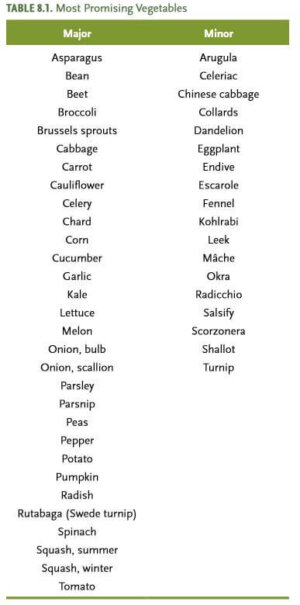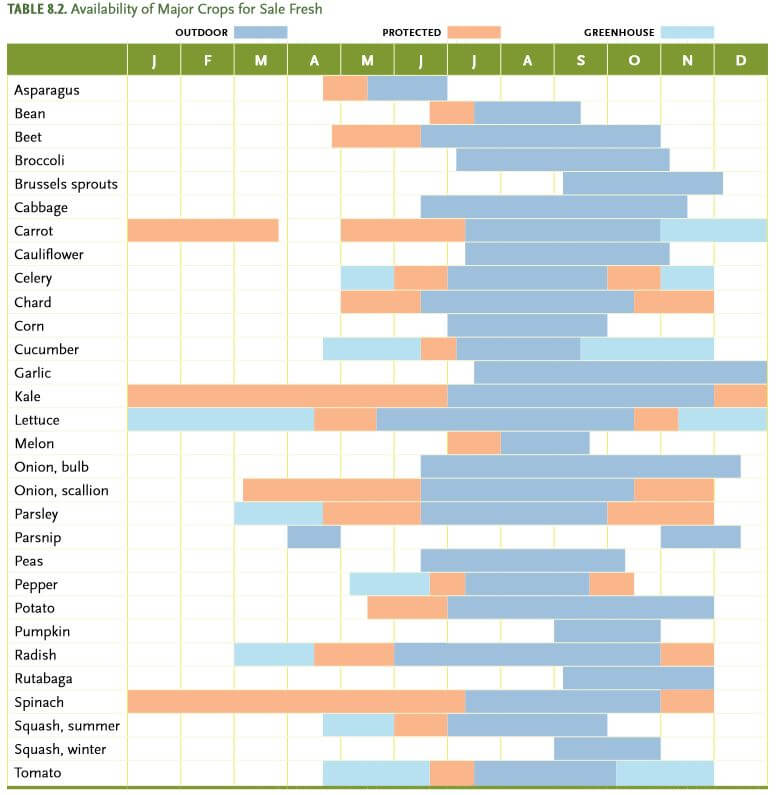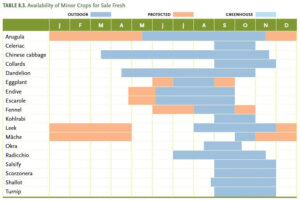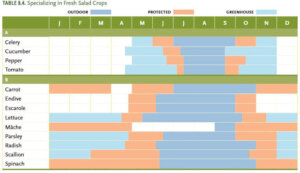
[ad_1]
On the brink of do some backyard planning? Listed here are among the most promising veggies that Eliot Coleman suggests to start out with!
The next is an excerpt from The New Natural Grower by Eliot Coleman. It has been tailored for the net.
A Information to Backyard Planning
Once I started farming full-time alone land in Maine, I used to be extraordinarily lucky to have as pals and neighbors Scott and Helen Nearing.
The Nearings taught me a variety of financial survival abilities, however a very powerful had been planning and commentary. The Nearings demonstrated these two precious abilities at their greatest.
They had been cautious planners and organizers of the work to be executed and the crops to be grown and all the time sought out essentially the most environment friendly solution to accomplish any job at hand. They had been indisputably essentially the most virtually organized nation individuals I’ve ever met.
The truth is, I keep in mind marveling that Scott was the one nonagenarian I knew with plans for the longer term farm mission he could be engaged on ten years therefore.
Lots of Helen and Scott’s concepts and experiences as small farmers are described of their e book Dwelling the Good Life (Harborside, ME: Social Science Institute, 1954; reprinted, New York: Schocken, 1970).
Planning on Paper
I quickly realized to plan forward far more effectively than I ever had—to set out the entire 12 months’s work on paper in the course of the winter months and thus have a great grasp effectively upfront of what assets I would want, the place they might come from, how I’d purchase them, and the way a lot time I would allot to every job.
I organized a pocket book into sections for every vegetable crop, for yearly within the totally different rotations I used to be making an attempt out, for fertilization data on every area, and so forth.
There is no such thing as a solution to match the worth of organizing and planning beforehand.
The Nearings had been masters of commentary. They meticulously recorded all of the bits and items of information gleaned out of day-to-day farm actions—from which number of lettuce wintered over greatest to what mixture of elements made the best compost for peas.
A few of their observations got here from intentional comparative trials, however the majority got here by probability—from holding their eyes open and coaching themselves to note refined variations, the place much less perceptive observers would move by unaware.
Briefly, they by no means stopped studying and had been sensible sufficient to file what they seen so it might be of use to them sooner or later.
Taking a cue from the Nearings, step one, due to this fact, is to plan out your operation intimately. Let’s undergo this course of step-by-step to determine which crops to develop, in what portions, and the way to set all of it up.
What to Develop
Relying available on the market and the local weather in your space, the likelihood exists to develop anyplace from 1 to 70 or so fairly widespread vegetable crops.
Imaginative growers are rediscovering previous crops every single day. John Evelyn in his 1699 essay “Acetaria: A Discourse of Sallets” listed 77 vegetable crops, and people had been simply salad elements.
The 48 greens I take into account essentially the most promising are listed in desk 8.1 and are divided into two classes, main and minor.
One solution to start deciding which greens to develop is to put in writing down in chart kind any info that may assist manage your planning. For instance, I would start by compiling a chart of the months when totally different greens may very well be obtainable on the market in the event that they had been grown in my space.
That chart ought to embrace the potential for prolonged availability of those crops if the rising season is supplemented by the safety of walk-in tunnels, the higher safety of a heated greenhouse, or out-of-season gross sales from a storage constructing.
Charts of the potential availability of crops on the market in my space, New England, would possibly seem like tables 8.2, 8.3, and eight.4.
Then, relying on whether or not I wished to develop simply seasonally or for an prolonged market, I’d have an concept which crops may very well be obtainable and when.
The benefit of compiling this type of info is that it stimulates considering. It would counsel a particular plan of action, reminiscent of a level of specialization, maybe.
All kinds of crops might be made obtainable year-round.
In lots of markets year-round manufacturing can assist maintain clients or purchase restaurant contracts.
The “A” crops in desk 8.4 are essentially the most probably profitable for the grower, however they’re additionally the costliest to provide. They want increased temperatures, requiring extra heating prices and a extra skilled greenhouse, one that’s taller and stronger for trellising.
Additionally they usually are not really year-round crops, though they’re long-season. Solely essentially the most specialised producers plan on harvesting earlier than April and after November.
The “B” crops might be grown in less complicated tunnel greenhouses at decrease temperatures.
Some, reminiscent of mâche, parsley, scallions, spinach, and carrots, might be grown as fall crops with no supplementary warmth in any respect.
They are often harvested unexpectedly earlier than actual chilly units in, or over a great a part of the winter by offering simply sufficient warmth to maintain them from freezing. The choice will depend on your market.
Probably the most fundamental year-round greenhouse crop is lettuce. It’s all the time in demand. Wonderful varieties for winter manufacturing can be found via the specialty seed catalogs. When you use an tailored selection, you’ll be able to develop lettuce at low temperatures and plan winter harvesting on an everyday schedule.
Manufacturing Dimension
This can be a perform of quite a lot of different elements. How a lot land is on the market? How fertile is it? What number of staff are concerned? What sort of gear is readily available?
As I mentioned earlier, I take into account 11/2 to 2 acres (6,070 to eight,095 sq. meters) of intensive manufacturing to be best. The choice concerning the dimension of a productive farm can’t be made in a vacuum.
The connection of dimension to the entire manufacturing and advertising and marketing elements must not ever be forgotten.
The market-garden structure will clearly be decided by the lay of the land, however as well as there are some normal options which might be relevant nearly in every single place.
Subdivision
It doesn’t matter what dimension the sphere, it must be subdivided. One-hundred-foot-long (30 meter) sections are an environment friendly dimension for the dimensions of equipment for use.
A 5-acre (2 hectares) area, sectioned off, would possibly seem like this:
Ideally, the sphere will slope to the south. The beds run throughout the sphere. Every mattress is 100 toes (30 meters) lengthy.
The areas between the sections, which permit for entry and turning a strolling tractor/tiller on the finish of every row, are 10 toes (3 meters) vast.
There are some stable causes for subdividing. Ease of entry, of calculating enter and manufacturing info, and of normal group are only a few.
A very powerful cause is administration.
Subdivision makes it simple to control every little thing. Care is the important thing, and nothing have to be uncared for. Subdivision helps to get you and your consideration to each a part of the operation.
The crop that would simply be forgotten in the course of a big area is extra more likely to obtain care in a smaller house. It doesn’t matter what the form of the rising space, it ought to in some way be divided into workable sections.
Format and Crop Spacing
The divisions above should now be progressively subdivided once more. Simply as a rustic is less complicated to grasp when it’s divided into states, counties, and cities, a backyard is extra understandable as sections and strips and rows.
Every part is 100 toes (30 meters) by 30 toes (10 meters), or 1/14 of an acre (285 sq. meters). A mattress is part of a piece 100 toes lengthy by 30 inches (75 centimeters) vast. That creates 8 (30-inch) beds facet by facet in every part.
Foot visitors must be confined to the entry paths between the beds so as to keep away from soil compaction within the rising space.
Pondering when it comes to beds helps to make the manufacturing system extra versatile.
Any mattress might be planted after harvest to a succession crop or to a inexperienced manure independently of the remainder of the part.
One helpful trace: Once you’re tilling throughout a sloped area utilizing a strolling tractor, begin on the uphill fringe of the realm to be tilled.
Then, as you until the second and subsequent passes, it will likely be the higher wheels that sink barely within the softened soil, making a leveling and barely terraced impact to the sphere.
When you begin on the backside edge, this impact is reversed, and the lean of the sphere is elevated by the sinking wheels. It turns into more durable to maintain the tractor in line and to maintain the sphere floor even.
For an operation specializing in salads I like to recommend a strolling tractor with a 30-inch tiller and the wheels set on 42-inch (105 centimeter) facilities.
You may then until the 30-inch-wide rising space in a single move.
The 12-inch (30 centimeter) entry paths are cultivated with the 12-inch knife on the wheel hoe.
I started utilizing 30-inch-wide beds separated by a 12-inch path years in the past for sure greenhouse crops, and I quickly tailored it to the sphere.
I discover it particularly appropriate when specializing in multicrop, contemporary salad manufacturing the place I’m doing numerous a number of harvests of low-growing crops and I would like to have the ability to shortly transfer throughout the sphere.
It’s simple to step throughout a 30-inch-wide rising space, and you may straddle it comfortably if you want whereas harvesting or transplanting.
Really useful Reads
[ad_2]



